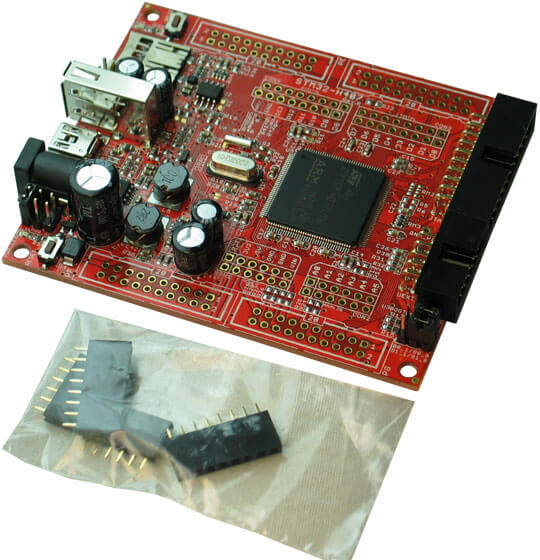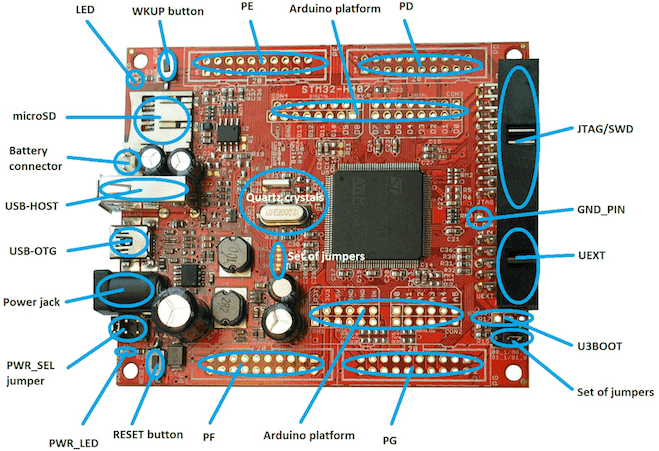OLIMEX-STM32-H407¶
Overview¶
The OLIMEX-STM32-H407 is open source hardware and is based on the STMicroelectronics STM32F407ZG ARM Cortex-M4 CPU.

OLIMEX-STM32-H407¶
Hardware¶
Information about the board can be found at the OLIMEX-STM32-H407 website and OLIMEX-STM32-H407 user manual. The ST STM32F407ZG Datasheet contains the processor’s information and the datasheet.
Supported Features¶
The olimex_stm32_h407 board configuration supports the following hardware features:
Interface |
Controller |
Driver/Component |
|---|---|---|
NVIC |
on-chip |
nested vectored interrupt controller |
SYSTICK |
on-chip |
system clock |
UART |
on-chip |
serial port |
GPIO |
on-chip |
gpio |
Other hardware features are not supported by the Zephyr kernel.
Pin Mapping¶

OLIMEX-STM32-H407 connectors¶
LED¶
LED (green) = PC13
PWR_LED (red) = power
Push buttons¶
BUT = PA0
RST = NRST
External Connectors¶
JTAG/SWD debug
PIN # |
Signal Name |
Pin # |
Signal Name |
|---|---|---|---|
1 |
+3.3V |
11 |
|
2 |
+3.3V |
12 |
GND |
3 |
PB4 / TRST |
13 |
PB3 / TDO |
4 |
GND |
14 |
GND |
5 |
PA15 / TDI |
15 |
PB4 / TRST |
6 |
GND |
16 |
GND |
7 |
PA13 / TMS |
17 |
|
8 |
GND |
18 |
GND |
9 |
PA14 / TCK |
19 |
+5V_JTAG |
10 |
GND |
20 |
GND |
UEXT
PIN # |
Wire Name |
STM32F407 port |
|---|---|---|
1 |
+3.3V |
|
2 |
GND |
|
3 |
PC6/USART6_TX |
PC6 |
4 |
PC7/USART6_RX |
PC7 |
5 |
PB8/I2C1_SCL |
PB8 |
6 |
PB9/I2C1_SDA |
PB9 |
7 |
PC2/SPI2_MISO |
PC2 |
8 |
PC3/SPI2_MOSI |
PC3 |
9 |
PB10/SPI_SCK/UART3_TX |
PB10 |
10 |
RB7/UEXT_CS |
PB7 |
Arduino Headers¶
CON1 power
Pin |
Signal Name |
STM32F407 Pin# |
|---|---|---|
RST |
RESET |
25 |
3V3 |
VCC (3V3) |
N/A |
5V |
VDD (5V) |
N/A |
GND |
GND |
N/A |
GND |
GND |
N/A |
VIN |
VIN |
N/A |
CON2 analog
Pin |
Signal Name |
STM32F407 Pin# |
|---|---|---|
A0 |
PC0 |
26 |
A1 |
PC1 |
27 |
A2 |
PB0 |
46 |
A3 |
PB1 |
47 |
A4 |
PC4 |
44 |
A5 |
PC5 |
45 |
CON3 digital
Pin |
Signal Name |
STM32F407 Pin# |
|---|---|---|
D0 |
PA3/USART2_RX |
37 |
D1 |
PA2/USART2_TX |
36 |
D2 |
PG7 |
92 |
D3 |
PG8 |
93 |
D4 |
PG12 |
127 |
D5 |
PG13 |
128 |
D6 |
PG14 |
129 |
D7 |
PG15 |
132 |
CON4 digital
Pin |
Signal Name |
STM32F407 Pin# |
|---|---|---|
D8 |
PA1 |
35 |
D9 |
PB11 |
70 |
D10 |
PA4 |
40 |
D11 |
PA7 |
43 |
D12 |
PA6 |
42 |
D13 |
PA5 |
41 |
GND |
AGND |
31 |
AREF |
AREF |
32 |
PD
PIN # |
Signal Name |
Pin # |
Signal Name |
|---|---|---|---|
1 |
+3.3V |
11 |
PD8 |
2 |
GND |
12 |
PD9 |
3 |
PD0 |
13 |
PD10 |
4 |
PD1 |
14 |
PD11 |
5 |
PD2/SD_CMD |
15 |
PD12 |
6 |
PD3 |
16 |
PD13 |
7 |
PD4 |
17 |
PD14 |
8 |
PD5 |
18 |
PD15 |
9 |
PD6 |
19 |
+5V |
10 |
PD7 |
20 |
GND |
PE
PIN # |
Signal Name |
Pin # |
Signal Name |
|---|---|---|---|
1 |
+3.3V |
11 |
PE8 |
2 |
GND |
12 |
PE9 |
3 |
PE0 |
13 |
PE10 |
4 |
PE1 |
14 |
PE11 |
5 |
PE2 |
15 |
PE12 |
6 |
PE3 |
16 |
PE13 |
7 |
PE4 |
17 |
PE14 |
8 |
PE5 |
18 |
PE15 |
9 |
PE6 |
19 |
+5V |
10 |
PE7 |
20 |
GND |
PF
PIN # |
Signal Name |
Pin # |
Signal Name |
|---|---|---|---|
1 |
+3.3V |
11 |
PF8 |
2 |
GND |
12 |
PF9 |
3 |
PF0 |
13 |
PF10 |
4 |
PF1 |
14 |
PF11 |
5 |
PF2 |
15 |
PF12 |
6 |
PF3 |
16 |
PF13 |
7 |
PF4 |
17 |
PF14 |
8 |
PF5 |
18 |
PF15 |
9 |
PF6 |
19 |
+5V |
10 |
PF7 |
20 |
GND |
PG
PIN # |
Signal Name |
Pin # |
Signal Name |
|---|---|---|---|
1 |
+3.3V |
11 |
PG8/D3 |
2 |
GND |
12 |
PG9 |
3 |
PG0 |
13 |
PG10 |
4 |
PG1 |
14 |
PG11 |
5 |
PG2 |
15 |
PG12/D4 |
6 |
PG3 |
16 |
PG13/D5 |
7 |
PG4 |
17 |
PG14/D6 |
8 |
PG5 |
18 |
PG15/D7 |
9 |
PG6 |
19 |
+5V |
10 |
PG7/D2 |
20 |
GND |
System Clock¶
OLIMEX-STM32-H407 has two external oscillators. The frequency of the slow clock is 32.768 kHz. The frequency of the main clock is 12 MHz. The processor can setup HSE to drive the master clock, which can be set as high as 168 MHz.
Programming and Debugging¶
The OLIMEX-STM32-H407 board does not include an embedded debug tool interface. You will need to use ST tools or an external JTAG probe. In the following examples the Olimex ARM-USB-OCD-H is used.
If you have an external JTAG probe compliant with the default Zephyr OpenOCD
configuration, however, then applications for the olimex_stm32_h407 board
configuration can be built and flashed in the usual way (see
Building an Application and Run an Application for more details).
Flashing an application to the Olimex-STM32-H407¶
Connect the ARM-USB-OCD-H debugger to your host computer and to the JTAG port of the OLIMEX-STM32-H407 board. Then build and flash an application.
Here is an example for the Hello World application.
# From the root of the zephyr repository
west build -b olimex_stm32_h407 samples/hello_world
west flash
Run a serial host program to connect with your board:
$ minicom -D /dev/ttyUSB0
After resetting the board, you should see the following message:
***** BOOTING ZEPHYR OS v1.11.0 - BUILD: Mar 12 2018 03:12:40 *****
Hello World! arm
Debugging¶
Provided that you have a JTAG probe, you can debug an application in the usual way. Here is an example for the Hello World application.
# From the root of the zephyr repository
west build -b olimex_stm32_h407 samples/hello_world
west debug